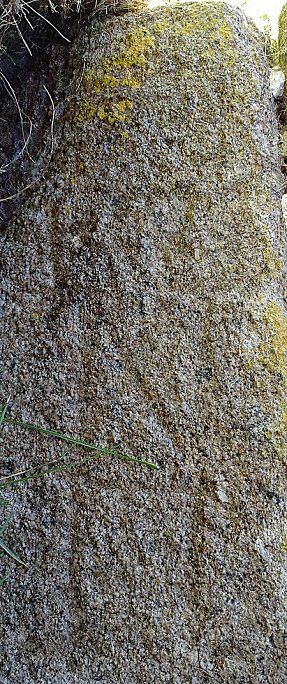
Access :
Leave St-Renan on the D68 road towards Argenton and continue straight. Turn right in front of the harbor towards Landunvez. After 800 m, turn left onto a small road signposted towards the St-Gonvel chapel. Then keep to the right and turn left onto the small road called Hent Sant Gonvel. The chapel appears on the right in the centre of a large grassy enclosure. Park near the entrance to the pen and proceed to the corner of the building just in front.
Ancient, many and unknown small monuments
See our page dedicated to the stèles gauloises du Second Âge du fer.


Two long stones form this coner. When we look at the one below, we recognize a Gallic stele with a chamfered edge that appears well.


This stone is 1.50 m long and has a short base of 0.20 m. Its visible side measures from 0.35 m to 0.54 m wide. At its top, which faces left to the south, the thickness of the stone is only 0.32 m. We can clearly distinguish engraved lines.
Let us look at it more closely. It was the subject of a sketch made by Father Yves-Pascal CASTEL, a specialist in religious heritage, in 1991. By straightening the picture, it can be better compared to the drawing.

The stele was wet to make the engravings appear better. |

Original drawing by Father Yves-Pascal Castel. |
Drawing engravings made on stone is a very difficult exercise. Especially when you have to get down to the ground to observe your model. It is necessary to try to distinguish the true engraved features from the natural cracks that the stone may contain. And to disregard any subjective interpretation.
We can see that the above drawing is quite far from reality. Especially at the character's chest. And his arms do not appear so clearly on the stele. We can also wonder if the cross drawn is real.
It seems, however, that the engraving does indeed depict a standing character. There is no little more to say. And it is impossible to date this ornamentation. When the stele indicated the location of a funeral urn? And the character might be the deceased ? 1
Or much later when the monks arrived from across the Channel, as the sketch suggests ?
Its position as the cornerstone of a chapel clearly indicates that it was intended to be Christianized. Where was it originally located ? Perhaps in the immediate vicinity in the sand of the dune.
Used to mark one or more funeral urns several centuries before our era, it is very possible that it had the same function as the current calvary with the burials that surrounded the chapel in the Middle Ages.
-1- According to the historian Jean-Yves Eveillard, if the stele dates back to the Iron Age, the engraving is very later and probably dates back to the Middle Ages. No known engraving of the Iron Age on a stone represents a character. It can therefore be said that the engraving was made on the stele while it was probably still standing, before the construction of the chapel.
***
READ MORE

Landunvez, Saint Gonvel, a truncated chapel
by Yves-Pascal CASTEL. Article published in Le Courrier du Léon et du Tréguier dated 16 March 1991.





